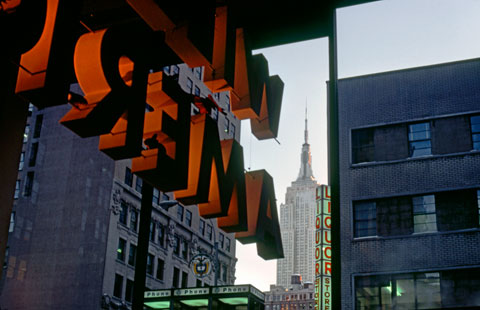
Kodak Gallery at 43rd Street and the Avenue of the Americas, 1978, (current location of ICP) — © Brian Rose
When I first began shooting color in the mid-70s, making prints was difficult. You couldn’t easily set up a home darkroom–color enlargers were expensive, and the chemicals were finicky compared to black and white. So, for several years I just shot slide film, mostly Kodachrome, which could be projected on a screen or looked at through a hand-held viewer. In my first color classes at Cooper Union taught by Joel Meyerowitz, all our discussions and critiques involved images that were projected. Meyerowitz, at that time, was exhibiting his work as dye transfer prints made directly from Kodachromes. They were beautiful, archival, required a custom lab, and were very expensive.
At some point I began teaching myself how to print color using an enlarger newly installed at school. There was no printing class. The chemicals were poured into a drum, which rotated on a mechanical base, and I could do prints up to 11×14 inches. To make prints from Kodachromes, I first had 4×5 internegatives made, with the end product being a so-called C print. The printing process was slow and labor intensive, and the results were sometimes less than perfect. But I made 25 prints one semester, and had an exhibition in the hall of the photo department. I also began shooting and printing from 35mm negative film, though I still liked working with the generous size of 4×5 internegatives. Looking back, that probably influenced my decision to shoot with the 4×5 view camera in doing the Lower East Side project with Ed Fausty. I liked printing from big sheets of film.
The one constant in all of this–film, paper, and chemistry–was Kodak. I had yellow boxes everywhere in my apartment until a few years later when green Fuji boxes began to infiltrate. I still have yellow Kodak boxes of film in my refrigerator and dozens of print boxes on the shelves in my studio. Although 90% of what I do now is digital, I will never entirely escape the yellow boxes.
Yesterday, not unexpectedly, Kodak filed for bankruptcy. Fujifilm continues on, a nimbler, smarter company, making some of the coolest digital cameras around. However, Kodak remains the only producer of negative sheet film, and although Chapter 11 does not mean it’s over for the company, my guess is that it will rapidly shrink, and eventually spin off different operations as separate companies. Where that leaves those of us still shooting film is anybody’s guess.
The photograph above was made in 1978 with my first camera, a 35mm Nikkormat, on Kodachrome. The Empire State Building was seen from below street level in the former Kodak gallery at 43rd Street and Sixth Avenue. The International Center of Photography now occupies that space. Kodak may soon exit the scene for good, but photography lives on, with or without yellow boxes.